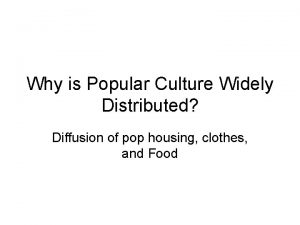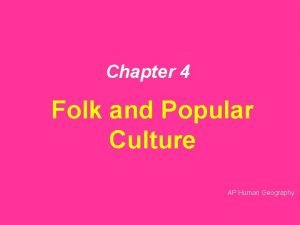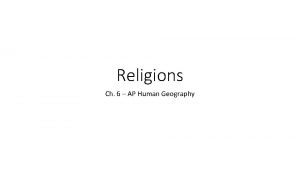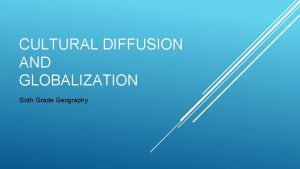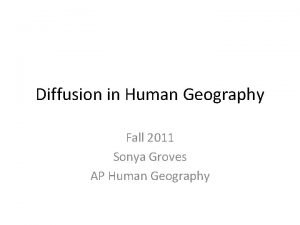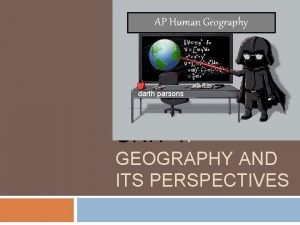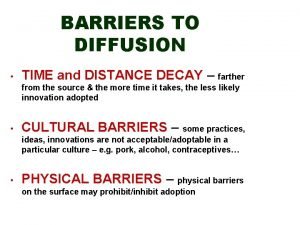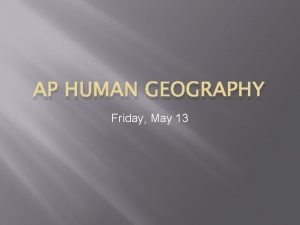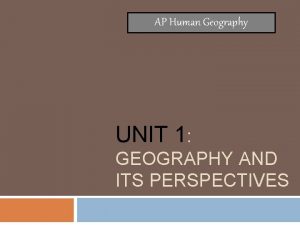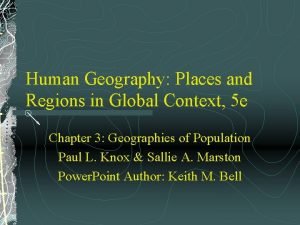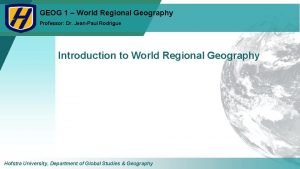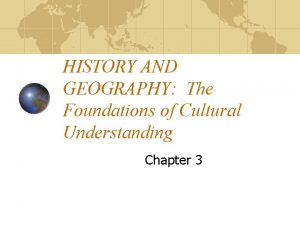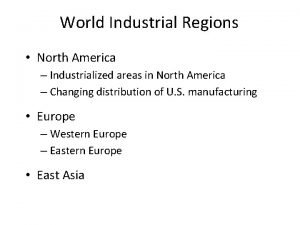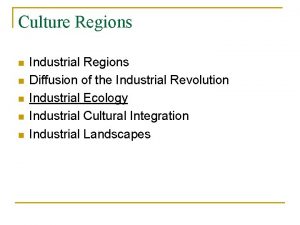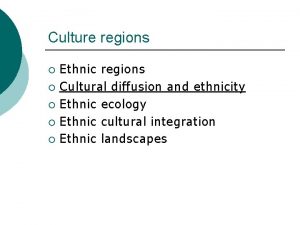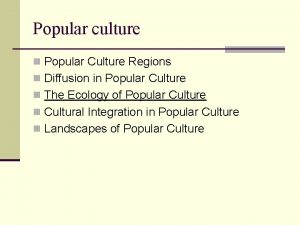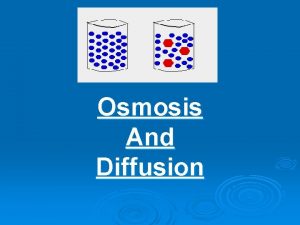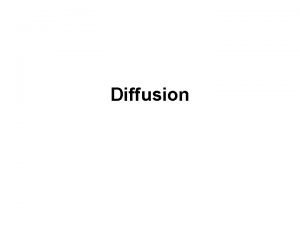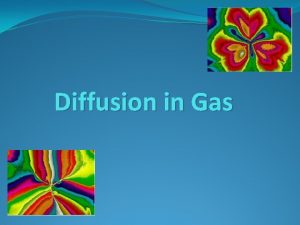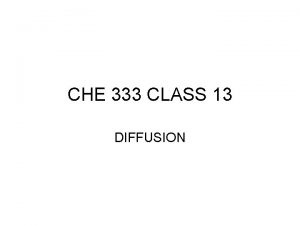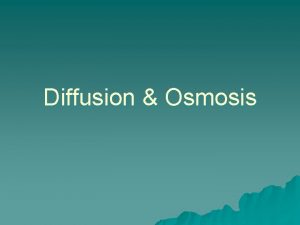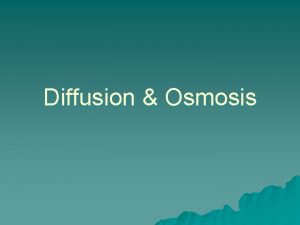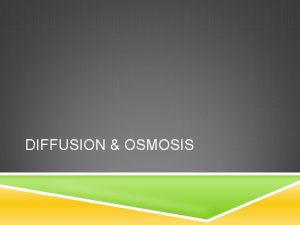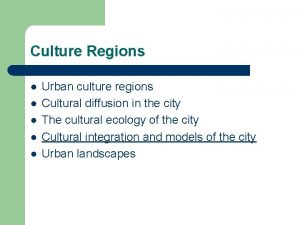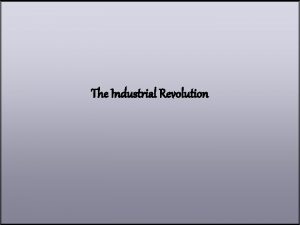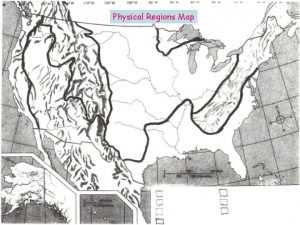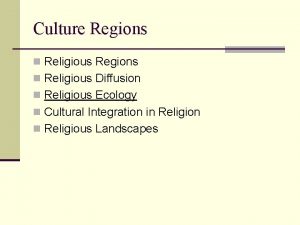INDUSTRIAL GEOGRAPHY Culture Regions Industrial Regions Diffusion of






































- Slides: 38

INDUSTRIAL GEOGRAPHY

Culture Regions • • • Industrial Regions Diffusion of the Industrial Revolution Industrial Ecology Industrial Cultural Integration Industrial Landscapes

Introduction • World map of formal industrial regions provides a good measure of how far the Industrial Revolution has spread • Generally, people resist substantial changes in their basic cultural patterns • The Industrial Revolution offered personal benefit, causing many people from many cultures to discard tradition


Introduction • Life before the Industrial Revolution – People were concerned with the most basic of primary economic activities – Acquired the necessities of survival from the land – Society and culture was overwhelmingly rural and agricultural – Before 1700 virtually all manufacturing was carried on in two systems, cottage and guild industries, both depended on hand labor and human power

Introduction • Cottage industry – Most common, was practiced in farm homes and rural villages – Usually a sideline to agriculture – Objects for family use were made in each household – Most villages had a cobbler, miller, weaver, and smith who worked part-time at home – Skills passed from parents to children with little formality

Introduction • Guild industry – Consisted of professional organizations of highly skilled, specialized artisans engaged full time in their trades and based in towns and cities – Membership came after a long apprenticeship – Was a fraternal organization of artisans skilled in a particular craft

Origins of the Industrial Revolution • Arose among back-country English cottage craftspeople in the early 1700 s • First: human hands were replaced by machines in fashioning finished products – Rendered the word manufacturing (“made by hand”) obsolete – Weavers no longer sat at a hand loom, instead large mechanical looms were invented to do the job faster and more economically

Origins of the Industrial Revolution • Second: Human power gave way to various forms of inanimate power – Machines were driven by water power, burning of fossil fuels, and later hydroelectricity and the energy of the atom – Men and women became tenders of machines instead of producers of fine handmade goods • Within 150 years, the Industrial Revolution greatly altered the first three sectors of industrial activity

Origins of the Industrial Revolution • Textiles – Initial breakthrough occurred in the British cotton textile cottage industry, centered in the Lanchashire district of western England – First changes were modest and on a small scale • Mechanical looms, powered by flowing water were invented • Industries remained largely rural • Diffused hierarchically to sites of rushing streams – Later in the eighteenth century invention of the steam engine provided a better source of power – In the United states, textile plants were also the first factories

Origins of the Industrial Revolution • Metallurgy – Traditionally, metal industries had been smallscale, rural enterprises – Situated near ore sources – Forests provided charcoal for smelting process – Chemical changes that occurred in steel making remained mysterious even to craftspeople who used them – Techniques had changed little since the beginning of the Iron Age, 2500 years before

Origins of the Industrial Revolution • Metallurgy – In the 1700 s, inventions by iron makers in the Coalbrookdale of English Midlands, created a new scientific, large-scale industry • Coke, nearly pure carbon, which is derived from nearly pure coal, replaced charcoal in the smelting process • Large blast furnaces replaced the forge • Efficient rolling mills took the place of hammer and anvil • Mass production of steel resulted

Origins of the Industrial Revolution • Mining – First to feel effects of new technology was coal mining • Adoption of steam engine necessitated huge amounts of coal to fire boilers • Conversion to coke further increased demand for coal • Fortunately, Britain had large coal deposits • New mining techniques and tools were invented • Coal mining became a large-scale mechanized industry

Origins of the Industrial Revolution • Mining – Because coal is heavy and bulky, manufacturing industries began flocking to the coal fields, to be near supplies – Similar modernization occurred in mining of iron ore, copper, and other metals needed by growing industries

Origins of the Industrial Revolution • Railroads – Wooden sailing ships gave way to steel vessels driven by steam engines – Canals were built – British-invented railroad came on the scene – Need to move raw materials and finished products from place to place, cheaply and quickly, was main stimulus leading to transportation breakthroughs

Origins of the Industrial Revolution • Railroads – Impact of the Industrial Revolution would have been minimized if distribution of goods and services had not been improved – British revolutionized shipbuilding industry and dominated it from their Scottish shipyards even into the twentieth century – New modes of transport fostered additional cultural diffusion – New industrial-age popular culture could easily penetrate previously untouched areas

Diffusion from Britain • For a century, Britain held a virtual monopoly on its industrial innovations – Government actively tried to prevent diffusion – Gave Britain enormous economic advantage – Contributed greatly to growth and strength of British Empire


Diffusion from Britain • The technology finally diffused beyond the British Isles – Continental Europe first received its impact in last half of the nineteenth century • Took firm root hierarchically in coal fields of Germany, Belgium, and other nations of northwestern and Central Europe • Diffusion of railroads provides a good index


Diffusion from Britain • The technology finally diffused beyond the British Isles – United States began rapid adoption of new technology about 1850 – About 1900, Japan was the first major non. Western country to undergo full industrialization – In the first third of the 1900 s, diffusion spilled into Russia and Ukraine – Recently, countries such as Taiwan, South Korea, China, Indian, and Singapore joined the manufacturing age

The “Pre-industrial” World • Industrial development occurred before the Industrial Revolution – India and China – European commercial companies

The Industrial Revolution • Growing European domestic markets & a lacking labor force • Increased transportation and communications • Steam-power for ocean-going vessels

Situation Factors • If the cost of transporting the product exceeds the cost of transporting inputs, then the optimal plant location is as close as possible to the customer. • If the inputs are more expensive to transport, then locate near these. LOCATE NEAR THE INPUTS OR LOCATE NEAR THE CUSTOMER(MARKET)

BULK-REDUCING INDUSTRIES • Must be located near the original large input sources (COPPER) • Iron-Ore and coal (to make steel) Go where they are mined

Location Near Markets: 1. BULK-GAINING INDUSTRIES • Gains volume or weight during production • Soft Drinks: 2 inputs syrup and water, bulky, heavy to transport, ships syrup to bottlers, WATER IS EVERYWHERE, produce near customers

• 2. Perishable Products: milk, fresh fruit, newspapers (hard copy) • 3. Single-market manufacturers: products sold in 1 location near your market New York Fashions Car part plants are located near assembly plants

Transportation • Ship, rail, truck, or air: choose the cheapest one according to weight, how far it is being shipped • Trucks=short distance • Trains=long distance • Small bulk, high value=air freight Break of Bulk Point=intermodal: locate where can transfer among many transportation modes

Site Factors: Land, Labor, capital • Land-factories are usually rural or suburban, need large tracts of land to build 1 story (more energy efficient and cheaper) • Low-electrical rates • Amenities, mild climate, opportunities for outdoor recreation, usually south or west • Cultural centers or sports franchises, whatever the owner’s interests are

Labor: intensive industry is one in which labor is a high percentage of the expense. • -highly skilled to increase the profits • Less-skilled, inexpensive labor, Indonesia • (in Southeast U. S. ) • Textiles and clothing: spin fibers to make yarn, weave or knit yarn into fabric, bleach, dye, cutting, sewing into clothing or other products Usually located in plants where the input of cotton is grown, China, India, Pakistan, Uzbekistan, U. S.

Cotton Production

Capital: manufacturers borrow money to establish new factories or expand one • -vehicle industry moved to Michigan because banks made loans • -Silicon Valley-skilled labor and banks willing to invest in new ideas ¼ of all capital in U. S. spent on new industries here

LDCs: distribution of industry must seek loans from MDCs: • Difficult to do…. . WHY? • 1. unstable pol system • 2. high debt level • 3. ill-advised economic policies

Local and city gov’t provide incentives to locate industries there • 1. grants • 2. low-cost loans • 3. tax breaks http: //projects. flowingdata. com/walmart/

Footloose industries • Can locate anywhere, owners can choose an inferior place to maximize profits -pick a place to ensure survival of the firm -small firm, may pick for personal reasons

The Location Decision • Secondary industries are less dependent on resource location – Distance decay • Weber's model: the “least cost theory” – Minimization of three critical expenses 1. Transportation costs 2. Labor costs 3. Agglomeration

Factors of Industrial Location Maquiladoras: factory across the border in Mexico SEZ: Special economic zone (like SE China) -NAFTA Highway, favorable trade conditions, no import tariffs -cheap labor -Clustering – Political stability – Taxation policies – Environmental conditions

• • • De Blij, Harm, J. (2010). Human Geography People, Place and Culture. Hoboken, NJ: John Wiley & Sons Inc. Domosh, Mona, Neumann, Roderic, Price, Patricia, & Jordan-Bychkov, 2011. The Human Mosaic, A Cultural Approach to Human Geography. New York: W. H. Freeman and Company. Fellman, Jerome, D. , Getis, Arthur, & Getis, Judith, 2011. Human Geography, Landscapes of Human Activities. Boston, MA: Mc. Graw-Hill Higher Education. Pulsipher, Lydia Mihelic and Alex M. and Pulsipher, 2011. World Regional Geography, Global Patterns, Local Lives. W. H. Freeman and Company New York. Rubenstein, James M. (2008). An introduction to human geography The cultural landscape. Upper Saddle River, NJ: Pearson Prentice Hall. Benewick, Robert, & Donald, Stephanie H. (2005). The State of China Atlas. Berkeley: University of California Press.
 Does osmosis require energy
Does osmosis require energy Contagious diffusion diagram
Contagious diffusion diagram Popular culture diffusion
Popular culture diffusion How do the origins of folk and popular culture differ
How do the origins of folk and popular culture differ Folk culture definition ap human geography
Folk culture definition ap human geography Popular culture diffusion
Popular culture diffusion Taliban vs western values ap human geography
Taliban vs western values ap human geography Cultural diffusion definition geography
Cultural diffusion definition geography Diffusion definition geography
Diffusion definition geography Spatial interaction ap human geography
Spatial interaction ap human geography Stimulus diffusion
Stimulus diffusion Maladaptive diffusion ap human geography
Maladaptive diffusion ap human geography Geography diffusion
Geography diffusion Time distance decay definition
Time distance decay definition Voting districts definition ap human geography
Voting districts definition ap human geography Thematic map definition ap human geography
Thematic map definition ap human geography Human geography places and regions in global context
Human geography places and regions in global context Geography: realms, regions, and concepts (doc or html) file
Geography: realms, regions, and concepts (doc or html) file Material culture and nonmaterial culture
Material culture and nonmaterial culture Sociologists define a symbol as
Sociologists define a symbol as Batch culture vs continuous culture
Batch culture vs continuous culture Fed-batch
Fed-batch Individualistic culture vs. collectivist culture
Individualistic culture vs. collectivist culture American vs indian culture
American vs indian culture Stab culture and stroke culture
Stab culture and stroke culture Folk culture and popular culture venn diagram
Folk culture and popular culture venn diagram Subculture group
Subculture group What is folk culture
What is folk culture Tsi
Tsi Folk culture and popular culture venn diagram
Folk culture and popular culture venn diagram Adaptive culture from inert culture
Adaptive culture from inert culture Stab culture and stroke culture
Stab culture and stroke culture Lawn culture
Lawn culture Quality culture vs traditional culture
Quality culture vs traditional culture Surface culture deep culture and esol
Surface culture deep culture and esol History and geography: the foundations of culture
History and geography: the foundations of culture Religion and geography
Religion and geography Unit 3 ap human geography
Unit 3 ap human geography North america industrial regions
North america industrial regions


